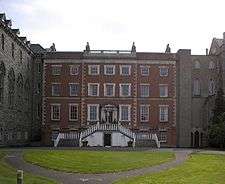Frances Mary Teresa Ball
Mother Frances Mary Teresa Ball (born in Dublin 9 January 1794; died 19 May 1861) was the foundress of the Irish Branch of the Institute of the Blessed Virgin Mary (IBVM).
Early life
Frances Ball was born 9 January 1794 in Dublin, Ireland to John and Mable Clare Bennet Ball; the youngest of six children. Her father was a wealthy silk weaver. Catholicism was still suppressed in Ireland at this time. She was therefore sent to England at the age of nine to the Bar Convent in York, which was an IBVM school,[1] although Mary Ward was not acknowledged as the foundress. This sisterhood, which had long existed at York, was originally established on the continent in the seventeenth century by Mary Ward to supply the means of a sound religious and secular education to young ladies. Henry James Coleridge describes her as "a bright, quiet, high spirited girl, fond of fun, and with much depth of character."[2] In these times students did not return home for Easter, Christmas or summer holidays. They stayed at the school, and lived like religious people, until they left school, usually in their late teens.
In 1807, her eldest sister, Cecilia was professed at the Ursuline convent in Cork. Frances travelled from Dublin to Cork for the ceremony, where she met Mary Aikenhead. Cecilia Ball took the name of Sister Francis Regis and was within a few years made Superior of the convent in Cork.[2] Upon the death of her father in 1808, Frances returned to Dublin.[1] Frances was expected to make an admirable wife for the son and heir of some rich Catholic Dublin merchant family.
In June 1814, under the direction of Dr. Daniel Murray, Archbishop of Dublin, Frances returned to York and entered the novitiate of the Institute of the Blessed Virgin Mary. There she received her religious training, and made her profession in September 1816, taking, in religion, the name of Mary Teresa.
Sisters of Loreto

Recalled by Archbishop Murray, she returned to Dublin with two novices, in 1821, to establish the Irish Branch of the Institute of the Blessed Virgin Mary for the instruction of children. They stayed with the Mary Aikenhead and the Irish Sisters of Charity in Stanhope Street while Rathfarnam House was being renovated.[2] In 1822 she opened the first institution of the order in Ireland, in Rathfarnam House, four miles from Dublin. Mother Teresa decided to call the house ’Loreto’ after the village in Italy to which the Nazareth house of the Holy Family was said to have been miraculously transported.[3]
Mother Frances was a woman of great piety and administrative ability. Her energies were devoted to the establishment of schools and to the development of the sisterhood which now has members in many countries.[1] The first offshoot was planted in Navan, County Meath, in the year 1833. The year 1840 was marked by the erection of the first church in Ireland dedicated to the Sacred Heart, in Loretto Abbey, Rathfarnham. In addition to the boarding and day schools the sisters conduct orphanages.[4] Her sister, Anna Maria helped her in the development of her schools, providing the funds for her to purchase the Loreto school on St Stephen's Green.[5]
Loreto schools
According to the local tradition, the house where the Holy Family lived in Nazareth was carried to Loreto, Italy by angels in the year 1295 to protect it from destruction. The Holy House of Loreto became one of the great pilgrimage centres of mediaeval Italy. The devotion of Mary Ward to the shrine at Loreto is well documented.
For almost forty years after bringing the IBVM to Ireland Teresa Ball established a wide network of convents and schools across Ireland, as well as in India, Mauritius and Canada. The nuns are usually called Loreto Sisters after the shrine at Loreto, Marche in Italy where Mary Ward used to pray. Mother Mary Teresa Ball died at Rathfarnham Abbey in May 1861 after a long illness.
References
- Drury, Edwin. "Mother Frances Mary Teresa Ball." The Catholic Encyclopedia. Vol. 2. New York: Robert Appleton Company, 1907. 9 Oct. 2014
- Coleridge S.J., Henry James.The life of mother Frances Mary Teresa Ball, Burns & Oates, London, 1881
- "Teresa Ball", Loreto IBVM India Archived 2015-01-11 at the Wayback Machine
- Gertrude, Sister Mary. "Irish Institute of the Blessed Virgin Mary." The Catholic Encyclopedia. Vol. 8. New York: Robert Appleton Company, 1910. 10 Oct. 2014
- Clarke, Frances (2009). "Ball, Anna Maria". In McGuire, James; Quinn, James (eds.). Dictionary of Irish Biography. Cambridge: Cambridge University Press.
. Dictionary of National Biography. London: Smith, Elder & Co. 1885–1900.
- Attribution
![]()